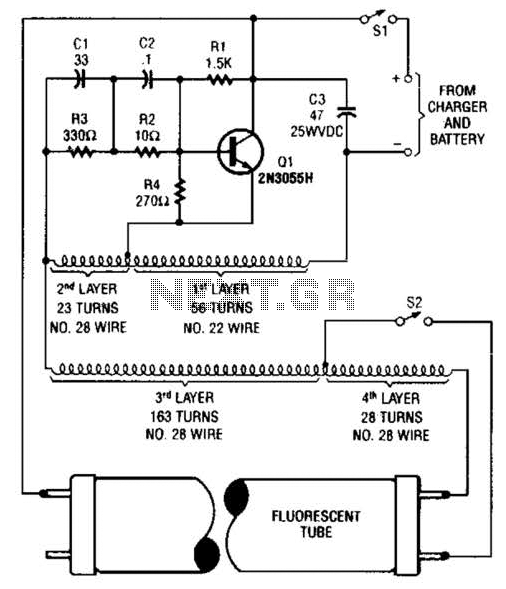
Fluorescent Tube Power Supply Circuit

A 2N3055 oscillator (Q1) drives a homemade transformer, wound on a Vk ferrite rod. S2 is used as a filament switch and can be eliminated if desired. A 20-W fluorescent tube is recommended. The supply voltage is 12 V.
The circuit employs a 2N3055 transistor configured as an oscillator, which is a common approach in power supply applications. The 2N3055 is a robust NPN power transistor capable of handling significant current and voltage levels, making it suitable for driving a transformer. In this design, the oscillator generates a high-frequency signal that is used to excite the transformer.
The transformer itself is custom-built, utilizing a Vk ferrite rod as the core material. Ferrite rods are advantageous in high-frequency applications due to their low losses and high magnetic permeability. The winding configuration of the transformer can be optimized to match the desired output characteristics for the fluorescent tube.
S2 functions as a filament switch, allowing for control over the filament power supply. While it provides convenience for switching the circuit on and off, it is noted that this component can be omitted if the application does not require independent control of the filament.
The system is designed to operate at a supply voltage of 12 V, which is a common voltage level for low-power applications. The recommendation of a 20-W fluorescent tube indicates the intended load for the circuit, suggesting that the design must accommodate the necessary current and voltage requirements to ensure proper operation of the tube.
In summary, this schematic provides a straightforward approach to building a fluorescent lamp driver using a 2N3055 transistor and a homemade transformer, suitable for applications requiring efficient power conversion and control. A 2N3055 oscillator (Ql) drives a homemade transformer, wound on a Vk, ferrite rod. S2 is used as a filament switch and it can be eliminated, if desired. A 20-W fluorescent tube is recommended. The supply is 12 V.
The circuit employs a 2N3055 transistor configured as an oscillator, which is a common approach in power supply applications. The 2N3055 is a robust NPN power transistor capable of handling significant current and voltage levels, making it suitable for driving a transformer. In this design, the oscillator generates a high-frequency signal that is used to excite the transformer.
The transformer itself is custom-built, utilizing a Vk ferrite rod as the core material. Ferrite rods are advantageous in high-frequency applications due to their low losses and high magnetic permeability. The winding configuration of the transformer can be optimized to match the desired output characteristics for the fluorescent tube.
S2 functions as a filament switch, allowing for control over the filament power supply. While it provides convenience for switching the circuit on and off, it is noted that this component can be omitted if the application does not require independent control of the filament.
The system is designed to operate at a supply voltage of 12 V, which is a common voltage level for low-power applications. The recommendation of a 20-W fluorescent tube indicates the intended load for the circuit, suggesting that the design must accommodate the necessary current and voltage requirements to ensure proper operation of the tube.
In summary, this schematic provides a straightforward approach to building a fluorescent lamp driver using a 2N3055 transistor and a homemade transformer, suitable for applications requiring efficient power conversion and control. A 2N3055 oscillator (Ql) drives a homemade transformer, wound on a Vk, ferrite rod. S2 is used as a filament switch and it can be eliminated, if desired. A 20-W fluorescent tube is recommended. The supply is 12 V.





